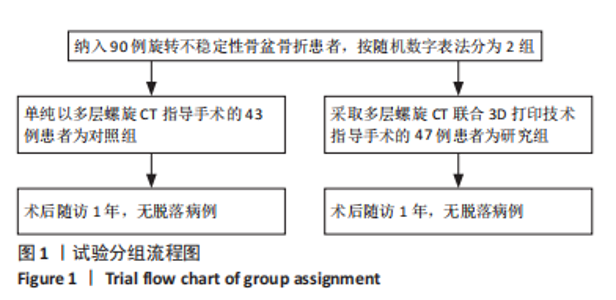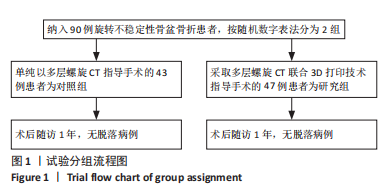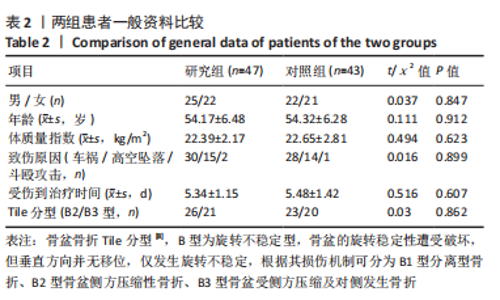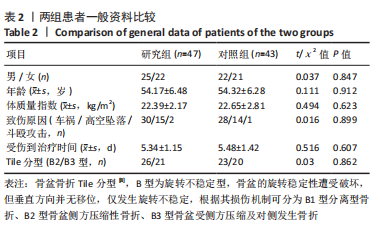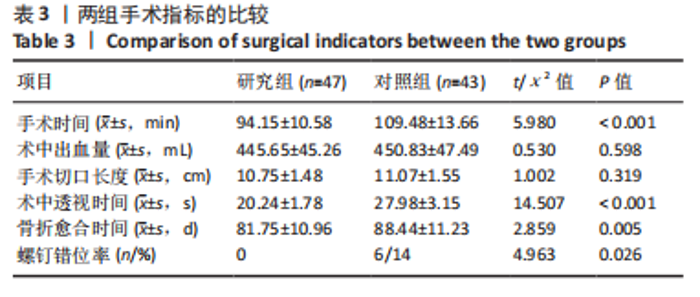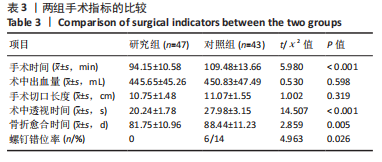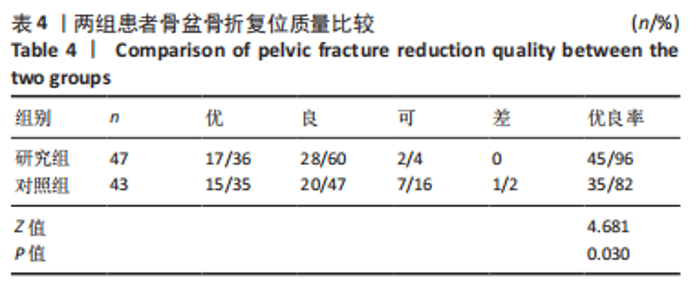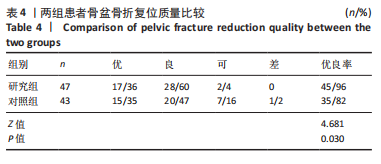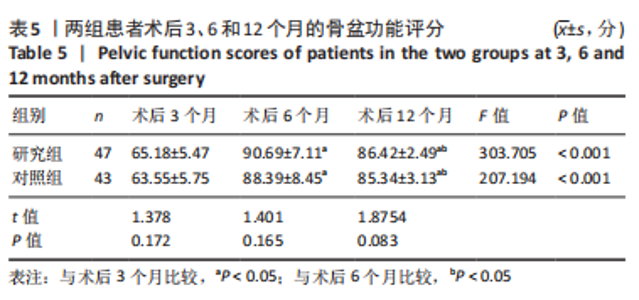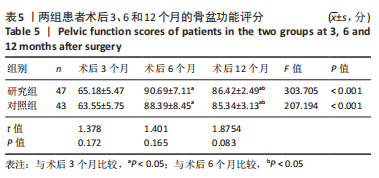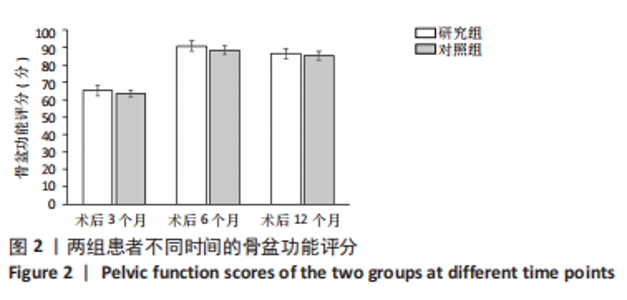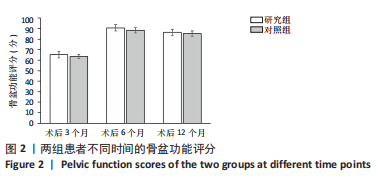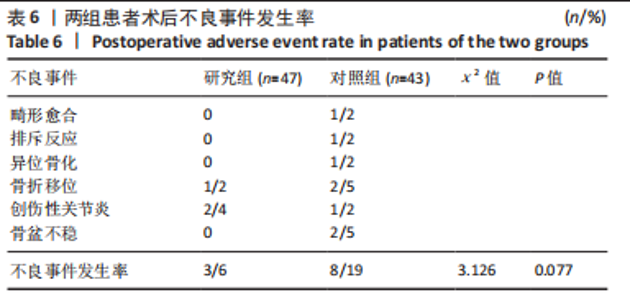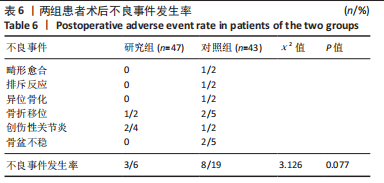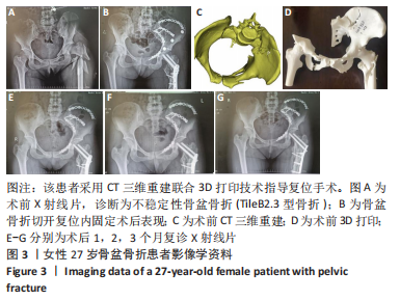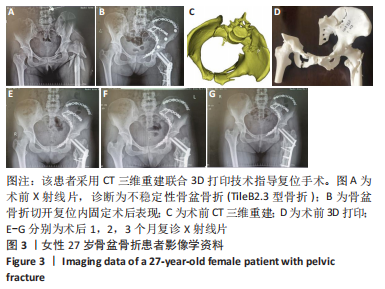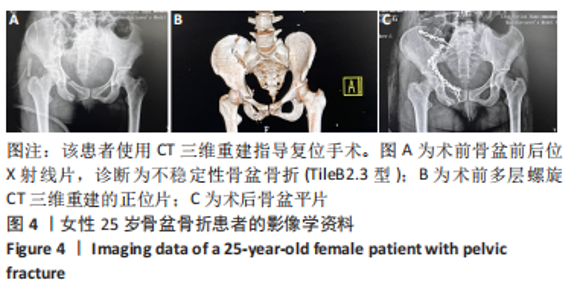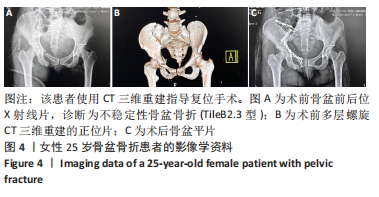Chinese Journal of Tissue Engineering Research ›› 2023, Vol. 27 ›› Issue (27): 4345-4350.doi: 10.12307/2023.602
Previous Articles Next Articles
Application of multi-slice spiral CT combined with 3D printing in the treatment of rotationally unstable pelvic fractures
Alimu·Keremu, Liang Zhilin, Pazila·Aila, Maimaitiaili·Abulikemu, Aikebaier·Tuxun
- Department of Orthopedics and Trauma, The First People’s Hospital of Kashi, Kashi 844000, Xinjiang Uygur Autonomous Region, China
-
Received:2022-04-29Accepted:2022-07-14Online:2023-09-28Published:2022-11-07 -
Contact:Aikebaier·Tuxun, Master, Associate chief physician, Department of Orthopedics and Trauma, The First People’s Hospital of Kashi, Kashi 844000, Xinjiang Uygur Autonomous Region, China -
About author:Alimu·Keremu, MD, Chief physician, Department of Orthopedics and Trauma, The First People’s Hospital of Kashi, Kashi 844000, Xinjiang Uygur Autonomous Region, China -
Supported by:“Pearl River Scholars·Tianshan Talents” Cooperative Studio Innovation Team Program, No. KDYY202020 (to AK); Xinjiang Tianshan Innovation Team Program, No. 2017D14015 (to AK)
CLC Number:
Cite this article
Alimu·Keremu, Liang Zhilin, Pazila·Aila, Maimaitiaili·Abulikemu, Aikebaier·Tuxun. Application of multi-slice spiral CT combined with 3D printing in the treatment of rotationally unstable pelvic fractures[J]. Chinese Journal of Tissue Engineering Research, 2023, 27(27): 4345-4350.
share this article
Add to citation manager EndNote|Reference Manager|ProCite|BibTeX|RefWorks
| [1] LIN SS, ZHOU SG, HE LS, et al. The effect of preperitoneal pelvic packing for hemodynamically unstable patients with pelvic fractures. Chin J Traumatol. 2021;24(2):100-103. [2] CAVALCANTI KUßMAUL A, GREINER A, KAMMERLANDER C, et al. Biomechanical comparison of minimally invasive treatment options for Type C unstable fractures of the pelvic ring. Orthop Traumatol Surg Res. 2020;106(1):127-133. [3] AL-DULIMI Z, WALLIS M, TAN DK, et al. 3D printing technology as innovative solutions for biomedical applications. Drug Discov Today. 2021;26(2):360-383. [4] PARK JW, KANG HG, KIM JH, et al. The application of 3D-printing technology in pelvic bone tumor surgery. J Orthop Sci. 2021;26(2): 276-283. [5] 中华医学会骨科学分会创伤骨科学组,中华医学会骨科学分会外固定与肢体重建学组,中华医学会创伤学分会,等.中国骨盆骨折微创手术治疗指南(2021)[J].中华创伤骨科杂志,2021,23(1):4-14. [6] TORNETTA P 3RD, MATTA JM. Outcome of operatively treated unstable posterior pelvic ring disruptions. Clin Orthop Relat Res. 1996;(329): 186-193. [7] MAJEED SA. Grading the outcome of pelvic fractures. J Bone Joint Surg Br. 1989;71(2): 304-306. [8] 沈红雷,冯德宏,许宏俊,等.CT三维重建技术判断骨盆骨折Tile分型与二维CT及X线的对比研究[J].河北医学,2019,25(6): 982-986. [9] SKITCH S, ENGELS PT. Acute management of the traumatically injured pelvis. Emerg Med Clin North Am. 2018;36(1):161-179. [10] PAVLIČEV M, ROMERO R, MITTEROECKER P. Evolution of the human pelvis and obstructed labor: new explanations of an old obstetrical dilemma. Am J Obstet Gynecol. 2020;222(1):3-16. [11] DUTTON RA. Stress fractures of the hip and pelvis. Clin Sports Med. 2021;40(2):363-374. [12] LUK L, TAFFEL MT. Cross-sectional anatomy of the male pelvis. Abdom Radiol (NY). 2020;45(7):1951-1960. [13] SUAREZ-WEISS KE, HEROLD A, GERVAIS D, et al. Hybrid imaging of the abdomen and pelvis. Radiologe. 2020;60(Suppl 1):80-89. [14] BURNER JM, DYER RB. The champagne glass pelvis. Abdom Radiol (NY). 2018;43(11):3190-3191. [15] DRYLEWICZ MR, LUBNER MG, PICKHARDT PJ, et al. Fatty masses of the abdomen and pelvis and their complications. Abdom Radiol (NY). 2019;44(4):1535-1553. [16] HAMMOND KE, KNEER L, CICINELLI P. Rehabilitation of soft Tissue injuries of the hip and pelvis. Clin Sports Med. 2021;40(2):409-428. [17] CHAN BY, LEE KS. Ultrasound intervention of the lower extremity/pelvis. Radiol Clin North Am. 2018;56(6):1035-1046. [18] ZULFIQAR M, LIN M, RATKOWSKI K, et al. Imaging features of neurofibromatosis type 1 in the abdomen and pelvis. AJR Am J Roentgenol. 2021;216(1):241-251. [19] ZULFIQAR M, SHETTY A, TSAI R, et al Diagnostic approach to benign and malignant calcifications in the abdomen and pelvis. Radiographics. 2020;40(3):731-753. [20] LEA WB, TUTTON SM, ALSAIKHAN N, et al. Pelvis weight-bearing ability after minimally invasive stabilizations for periacetabular lesion. J Orthop Res. 2021;39(10):2124-2129. [21] SUKERKAR PA, FAST AM, RILEY G. Extreme sports injuries to the pelvis and lower extremity. Radiol Clin North Am. 2018;56(6):1013-1033. [22] ZHENG Y, ELSAYES KM, WARANCH C, et al. IgG4-related disease in the abdomen and pelvis: atypical findings, pitfalls, and mimics. Abdom Radiol (NY). 2020;45(8):2485-2499. [23] Alyaev YG, Sirota ES, Bezrukov EA, et al. Non-biological 3D printed simulator for training in percutaneous nephro-lithotripsy. Urologiia. 2018;(1):10-14. [24] 苗鹏.多层螺旋CT三维重建辅助3D打印技术对复杂髋臼骨折手术的分析[J].中国CT和MRI杂志,2021,19(12):163-166. [25] WANG J, WANG X, WANG B, et al. Comparison of the feasibility of 3D printing technology in the treatment of pelvic fractures: a systematic review and meta-analysis of randomized controlled trials and prospective comparative studies. Eur J Trauma Emerg Surg. 2021; 47(6):1699-1712. [26] LUGO-FAGUNDO C, GHODASARA N, FISHMAN EK, et al. CT evaluation of self-induced and retained foreign bodies in the abdomen and pelvis. Clin Imaging. 2021;80:26-35. [27] BRANCH KRH, STROTE J, GUNN M, et al. Early head-to-pelvis computed tomography in out-of-hospital circulatory arrest without obvious etiology. Acad Emerg Med. 2021;28(4):394-403. [28] HAIMS AH, WANG A, YOO BJ, et al. Negative predictive value of CT for occult fractures of the hip and pelvis with imaging follow-up. Emerg Radiol. 2021;28(2):259-264. [29] ALEXANDER LF, HANNA TN, LEGOUT JD, et al. Multidetector CT findings in the abdomen and pelvis after damage control surgery for acute traumatic injuries. Radiographics. 2019;39(4):1183-1202. [30] TORRADO-CARVAJAL A, VERA-OLMOS J, IZQUIERDO-GARCIA D, et al. Dixon-VIBE deep learning (DIVIDE) pseudo-CT synthesis for pelvis PET/MR attenuation correction. J Nucl Med. 2019;60(3):429-435. [31] ROTHMAN RK, WEINREB J, ZUCCONI W, et al. Diagnostic value of CT of chest, abdomen, and pelvis in patients with solitary and multiple brain lesions. AJR Am J Roentgenol. 2020;214(3):636-640. |
| [1] | Wu Di, Si Lina, Wu Lizhu, Wang Jianhua, Luo Jinwei, Chang Qiankun, Lyu Yongming, Du Yuanliang. Feasibility of three-dimensional printing technology combined with computer-aided design in total knee arthroplasty for severe knee osteoarthritis [J]. Chinese Journal of Tissue Engineering Research, 2023, 27(13): 2051-2057. |
| [2] | Li Canhui, Wu Zhengjie, Zeng Yanhui, He Yinghao, Situ Xiaopeng, Du Xuelian, Hong Shi, He Jiaxiong. Advantage and disadvantage of robot-assisted sacroiliac screw placement and traditional fluoroscopy in orthopedic surgery [J]. Chinese Journal of Tissue Engineering Research, 2022, 26(9): 1434-1438. |
| [3] | Song Yuxin, Zhang Tongtong, Niu Jianxiong, Wang Zengping, Wen Jie, Zhang Qunli, Xue Wen, Liu Lin. Precise screw placement of 3D printing model and orthopedic robot in spinal deformity [J]. Chinese Journal of Tissue Engineering Research, 2022, 26(6): 904-907. |
| [4] | He Guowen, Hu Baijun, Gao Dawei, Chen Liang. Treatment of Schatzker type V and VI tibial plateau fractures with 3D printing preoperative planning combined with double reverse traction device [J]. Chinese Journal of Tissue Engineering Research, 2022, 26(36): 5764-5769. |
| [5] | Li Lu, Tang Wen. Screw placement in posterior route pedicle on subaxial cervical spine: how to improve the therapeutic effect with the development of artificial intelligence [J]. Chinese Journal of Tissue Engineering Research, 2022, 26(3): 474-479. |
| [6] | Jin Herong, Cui Jingbin, Shao Cang. Materials of interbody fusion cage: advantages and focus of clinical application [J]. Chinese Journal of Tissue Engineering Research, 2022, 26(22): 3592-3597. |
| [7] | Li Shan, Liu Chao, Yan Yiguo. Bio-functionalization of medical metal materials in orthopedic application [J]. Chinese Journal of Tissue Engineering Research, 2021, 25(34): 5523-5529. |
| [8] | Yang Jiujie, Wang Tao, Li Zhi, Yang Lifeng, Tian Ye, Bi Zheng, Zeng Yaling. Cervical spondylosis with osteoporosis treated by the new pedicle fixation system through the anterior cervical approach with three-dimensional printing technology: three-dimensional finite element analysis [J]. Chinese Journal of Tissue Engineering Research, 2021, 25(33): 5249-5253. |
| [9] | Wang Yihan, Li Yang, Zhang Ling, Zhang Rui, Xu Ruida, Han Xiaofeng, Cheng Guangqi, Wang Weil. Application of three-dimensional visualization technology for digital orthopedics in the reduction and fixation of intertrochanteric fracture [J]. Chinese Journal of Tissue Engineering Research, 2021, 25(24): 3816-3820. |
| [10] | Chen Jie, Liao Chengcheng, Zhao Hongbo, Zhao Wei, Chen Zhiwei, Wang Yan. Application of tissue engineering urethral stent and its preparation technology in urethral reconstruction [J]. Chinese Journal of Tissue Engineering Research, 2021, 25(22): 3591-3596. |
| [11] | Yao Lu, Hu Peixin, Liu Wu, Lü Qitao, Nie Zilin, He Zhengdi. Application and prospects of 3D printing technology in dental manufacturing [J]. Chinese Journal of Tissue Engineering Research, 2020, 24(4): 637-642. |
| [12] | Qin Yuxing, Ren Qiangui, Shen Peifeng. Superiority of tissue-engineered bone technology for treating bone defects [J]. Chinese Journal of Tissue Engineering Research, 2020, 24(24): 3877-3882. |
| [13] | Yuan Dechao, Wu Chao, Deng Jiayan, Wang Xiangyu, Li Tao, Tan Lun, Wang Wei, Luo Min . Construction and evaluation of 3D printing simulation model for lumbar surgery [J]. Chinese Journal of Tissue Engineering Research, 2020, 24(12): 1870-1874. |
| [14] | Lin Liulan, Zhou Jianyong. Application status of 3D printed polyetheretherketone and its composite in bone defect repair [J]. Chinese Journal of Tissue Engineering Research, 2020, 24(10): 1622-1628. |
| [15] | Cui Jiaming, Yang Dazhi. Treatment strategies for spinal metastases: advantages of 3D printing and precise treatment [J]. Chinese Journal of Tissue Engineering Research, 2019, 23(36): 5875-5881. |
| Viewed | ||||||
|
Full text |
|
|||||
|
Abstract |
|
|||||
